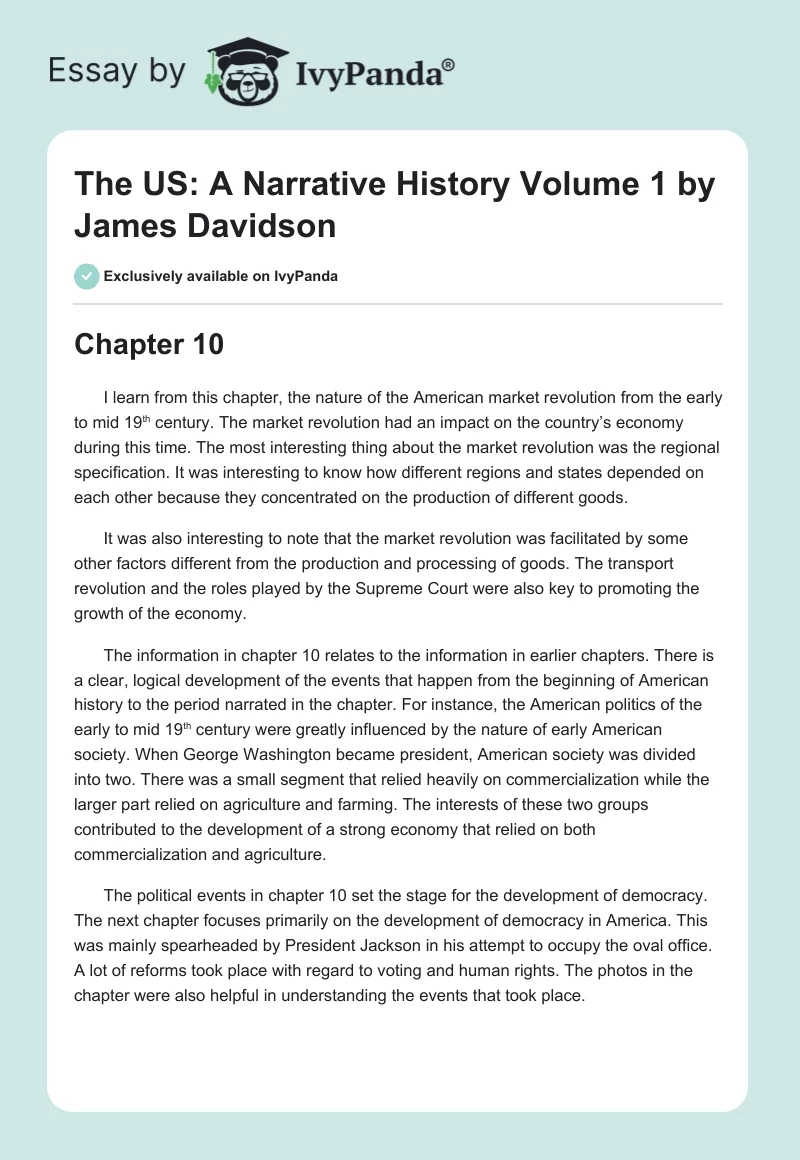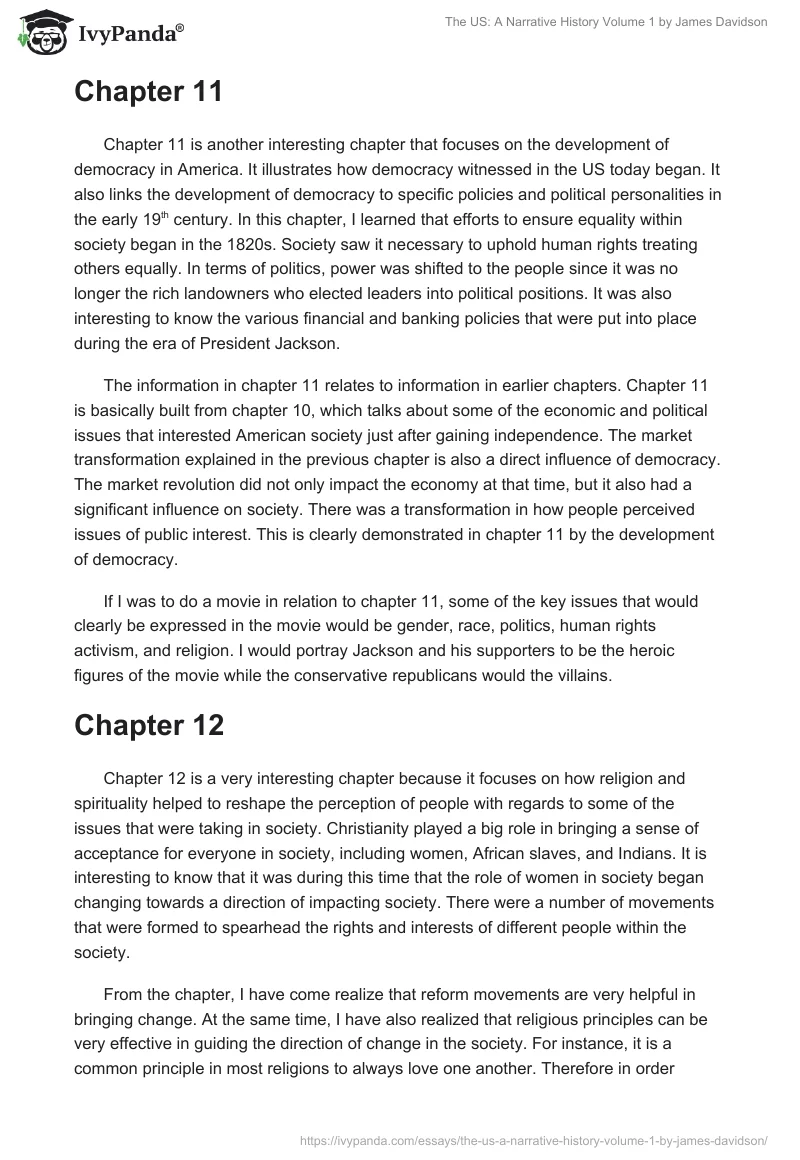Chapter 10
I learn from this chapter, the nature of the American market revolution from the early to mid 19th century. The market revolution had an impact on the country’s economy during this time. The most interesting thing about the market revolution was the regional specification. It was interesting to know how different regions and states depended on each other because they concentrated on the production of different goods.
It was also interesting to note that the market revolution was facilitated by some other factors different from the production and processing of goods. The transport revolution and the roles played by the Supreme Court were also key to promoting the growth of the economy.
The information in chapter 10 relates to the information in earlier chapters. There is a clear, logical development of the events that happen from the beginning of American history to the period narrated in the chapter. For instance, the American politics of the early to mid 19th century were greatly influenced by the nature of early American society. When George Washington became president, American society was divided into two. There was a small segment that relied heavily on commercialization while the larger part relied on agriculture and farming. The interests of these two groups contributed to the development of a strong economy that relied on both commercialization and agriculture.
The political events in chapter 10 set the stage for the development of democracy. The next chapter focuses primarily on the development of democracy in America. This was mainly spearheaded by President Jackson in his attempt to occupy the oval office. A lot of reforms took place with regard to voting and human rights. The photos in the chapter were also helpful in understanding the events that took place.
Chapter 11
Chapter 11 is another interesting chapter that focuses on the development of democracy in America. It illustrates how democracy witnessed in the US today began. It also links the development of democracy to specific policies and political personalities in the early 19th century. In this chapter, I learned that efforts to ensure equality within society began in the 1820s. Society saw it necessary to uphold human rights treating others equally. In terms of politics, power was shifted to the people since it was no longer the rich landowners who elected leaders into political positions. It was also interesting to know the various financial and banking policies that were put into place during the era of President Jackson.
The information in chapter 11 relates to information in earlier chapters. Chapter 11 is basically built from chapter 10, which talks about some of the economic and political issues that interested American society just after gaining independence. The market transformation explained in the previous chapter is also a direct influence of democracy. The market revolution did not only impact the economy at that time, but it also had a significant influence on society. There was a transformation in how people perceived issues of public interest. This is clearly demonstrated in chapter 11 by the development of democracy.
If I was to do a movie in relation to chapter 11, some of the key issues that would clearly be expressed in the movie would be gender, race, politics, human rights activism, and religion. I would portray Jackson and his supporters to be the heroic figures of the movie while the conservative republicans would the villains.
Chapter 12
Chapter 12 is a very interesting chapter because it focuses on how religion and spirituality helped to reshape the perception of people with regards to some of the issues that were taking in society. Christianity played a big role in bringing a sense of acceptance for everyone in society, including women, African slaves, and Indians. It is interesting to know that it was during this time that the role of women in society began changing towards a direction of impacting society. There were a number of movements that were formed to spearhead the rights and interests of different people within the society.
From the chapter, I have come realize that reform movements are very helpful in bringing change. At the same time, I have also realized that religious principles can be very effective in guiding the direction of change in the society. For instance, it is a common principle in most religions to always love one another. Therefore in order create a society that is based on love, then discriminations and human violations have to be eliminated. It is through movements and activism that discrimination can be eliminated in the society.
This chapter sets the stage for the discussion of chapter 13. It is through religion and societal values that one is identify the nature of bond that evident in the society. One can easily understand how slaves in the southern confederation used to cope with the situation. Most of them relied on religion to stay together and find solace in the circumstances that surrounded them.
If I were to make a movie about chapter 12, I would focus on issues such as activism, religion, churches, salvation, and spirituality.
Chapter 13
Chapter 13 has a time span of 40 years that begins from 1820 to 1860. It is an interesting chapter because it provokes a lot of thinking. The transformation witnessed in the American society during this time, was heavily concentrated on the northern part of the country. Nonetheless, the influence of this transformation began to be felt by southerners. From the chapter, one realizes the lack of uniformity in the changes witnessed in the society. Economic growth and development was witnessed in both parts of the country. However, the transformation in the society that resulted from religion was never uniform in both parts of the country.
It is interesting to know how the elite of the society in the north decided to unanimously do away with slavery because religious conviction. This aspect created a lot of pressure for the elites within the southern states to also abolish slavery.
The reading has also helped me to distinguish between sectionalism and nationalism. Therefore if I were to make a movie about chapter 13, I would focus primarily on the two concepts. The leaders in the North would definitely play the parts of nationalists because during this time, they fought to ensure that America does not split into two because of the issue of slavery. The leaders in the South would play the parts of sectionalists. This is because, during the period prior to the civil war, these leaders were adamant to continue with slavery. They were feeling the pressure to reform, but they refused to bow in.


